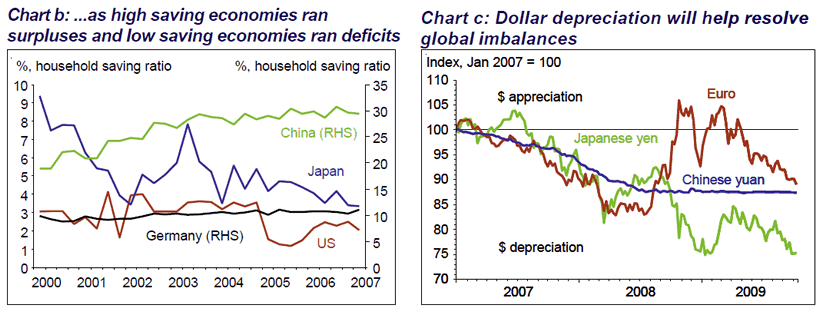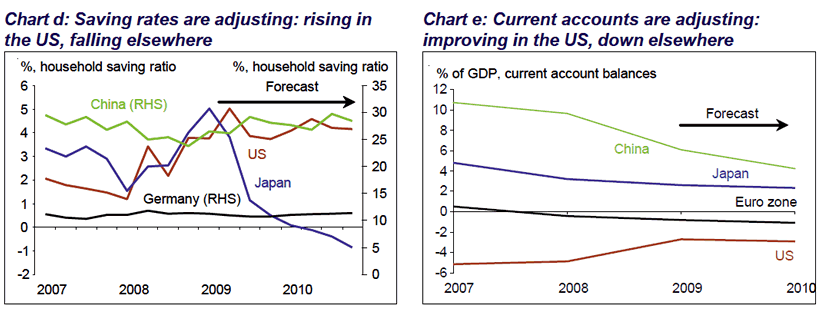Orderly U.S. Dollar Depreciation Is Better Than Protectionism
Currencies / US Dollar Oct 19, 2009 - 04:23 AM GMTBy: Lloyds_TSB
 For all of the furore about the dollar’s slide, it is easy to lose sight of the underlying forces at play. However, we should not be complacent, as these forces can still have destructive effects on global growth prospects. Global imbalances, represented broadly in the growing US current account deficit and rising surpluses in many other parts of the world, were one of the prime - for some, the only - reasons for the global crisis that is still unwinding.
For all of the furore about the dollar’s slide, it is easy to lose sight of the underlying forces at play. However, we should not be complacent, as these forces can still have destructive effects on global growth prospects. Global imbalances, represented broadly in the growing US current account deficit and rising surpluses in many other parts of the world, were one of the prime - for some, the only - reasons for the global crisis that is still unwinding.
 A necessary part of the adjustment to global imbalances is that the dollar must fall, or the US erects trade barriers to bring down its external deficits or there must be a recession so severe that it brings imports to a halt. That would be the ultimate nightmare scenario for the world economy.
A necessary part of the adjustment to global imbalances is that the dollar must fall, or the US erects trade barriers to bring down its external deficits or there must be a recession so severe that it brings imports to a halt. That would be the ultimate nightmare scenario for the world economy.
Thankfully, it is also the option that no one wants to see. This is why the global financial and economic crisis has not turned into a replay of the 1930s great depression - because economies were kept open and countries broadly agreed to use monetary and fiscal policy tools to help offset the effects of the downturn and the collapse in financial markets. But is the global imbalances genie back in the box and is sustainable rebalancing occurring?
The US represents the world’s largest economy and has its largest deficit
In 2007, the US current account deficit was the largest in the world in value terms, at $726bn (it peaked the year before at $803.5bn). This represented 6% of its $14trn gdp in nominal terms that year. For illustration, China had a current account surplus of 11.4% of its 2007 gdp, equivalent to $372bn. Germany had a similar profile, with a surplus of $266bn in 2007, or 8% of gdp.
So, what led to the imbalances captured in chart a? The short answer is shown in chart b. It appears to be no coincidence that the countries running deficits were also the ones with the lowest saving rates. In 2007, the US personal sector saving rate was 1.7% of annual disposable income. The equivalent figure for China was 28.3% and for Germany it was 10.7%. A similar profile was evident in fiscal balances as well, with the US running a deficit of 2.8% of gdp, but Germany had a surplus of 0.4% of gdp and China had one of 0.7% of gdp in 2007. It seems, therefore, that what links these deficits and surpluses are savings.
High global savings exist in some countries, mirroring the US deficit
The argument is that high global savings drove down interest rates and led to the increased leverage that then sowed the seeds of the current global recession and financial collapse. Therefore, these imbalances need to be addressed for the world economy to recover in a sustainable manner. Effectively, the savings economies must save less and the spending economies must save more. Injections of demand by governments will prevent the adjustment from being too abrupt, but cannot act as a long term substitute. Ultimately, leverage must fall in the indebted countries and rise in the less indebted economies. Some of this will come from governments in the latter saving less and some from encouraging spending by consumers. Another part of this process, though, also comes from exchange rate adjustments. Therefore, if this is indeed the case, recent trends should be reassuring.
Global imbalances are correcting, though it is uncertain how long this trend will last…
Global imbalances are correcting. The IMF estimates that the global imbalance is now 1½% of global gdp, down from 2½% as recently as 2008. Sticking to the focus on the US and Germany/eurozone and China, illustrates how this is happening. Chart c shows that the US dollar has seen an orderly depreciation since the crisis broke in 2007. Effectively, a fall in the US dollar means that US consumers get less for their consumption and more demand for their exports. This is an incentive for them to invest more, in order to export and so to consume fewer goods made abroad.

For the exporting or saving economies, it means the opposite: they get more from importing (i.e. their consumers are better off) and less for exporting, as their currencies appreciate. This should encourage spending behaviour and a reduction in savings. Hence, the recent fall in the US dollar, which is not against all currencies but mainly focused on those that it has big deficits with, does not presage the end of the dollar as the key global reserve currency. In fact, the reverse seems likely: a successful adjustment will make the eventual US recovery more sustainable and so dollar investments more value preserving.
Charts d and e show that US households are saving more and that the current account deficit has fallen. The opposite is happening in the surplus/saving economies. In 2009, the US current account deficit is estimated to be $410bn, 2.9% of gdp. US household savings are up to 4% of household disposable income in 2009 from the sub-2% two years before. China’s current account surplus in 2009 is projected at $331bn, and further reductions are projected. Its saving rate is also down, though only to 27.5% from 28%. For Germany, the household saving rate is still at 11% but the current account surplus has fallen to $129bn from the $266bn recorded in 2007.

…but dollar weakness is a necessary part of this adjustment It is easy to lose sight of the fact that the weakness of the dollar is necessary to right some of the imbalances that led to the global collapse. In fact, thinking of this as purely dollar weakness is wrong, in our view. Many of the currencies the dollar is depreciating against have large dollar reserves, not because their economies are more productive than the US or more competitive, but because they have been deliberately keeping their currencies weak. This has contributed to big surpluses in the case of these economies and big deficits in the case of the US. But, at some stage there needs to be an adjustment - better it comes though market forces pushing these other currencies higher than from US protectionism.
Trevor Williams, Chief Economist, Corporate Markets
For more information: Emile Abu-Shakra Manager, Media Relations Lloyds TSB Group Media Relations Tel 020 7356 1878 http://www.lloydstsbcorporatemarkets.com/
Lloyds TSB Archive |
© 2005-2022 http://www.MarketOracle.co.uk - The Market Oracle is a FREE Daily Financial Markets Analysis & Forecasting online publication.



